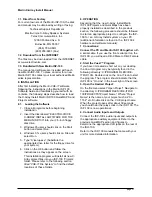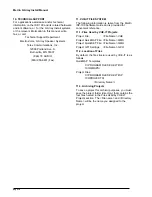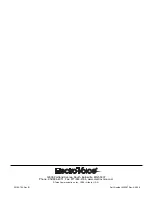
Merlin X-Array Install Manual
page 13
4. Set the mid-bass-frequency analog output gains
to –8 dB. From the Vue-It program, click on any
of the green input triangles to open the analog
gain menu. Go to the output-gain sub menus for
the mid-bass-frequency outputs (outputs 5B and
3A) and select –8 dB for the output gain.
5. Increase the mid-bass-frequency digital gain in
the “Filters” menu by +8 dB. From the Vue-It
program, click on the “Filters” blocks in the mid-
bass-frequency outputs (“Filter_a_Mid” and
“Filter_b_Mid”) and, from the menus, increase
the gain by +8 dB above that indicated in the
factory QuickSet.
6. Increase the mid-bass-frequency limiter
thresholds from the “Limiter” menus by +8 dB.
From the Vue-It program click on the “Limiter”
blocks in the mid-bass-frequency outputs
(“Limiter_a_Mid” and “Limiter_b_Mid”) and, from
the menus, increase the thresholds by +8 dB
above that indicated in the factory QuickSet.
7.
Save your changes. From the Vue-it program,
click on the "Update" button in the QuickSET
Manager panel to save your changes to the
current QuickSET. Then select "Save" from the
File menu to update your entire project to disk.
These adjustments will work with most program
material; however, if “In Processing” clipping occurs
in the digital path of either the mid-bass- or high-
frequency output section, the gain adjustment can
be decreased. For example, instead of an 8-dB
adjustment, a 6-dB adjustment can be tried. (In
other words, set the analog output gains to –6 dB,
then increase the digital gains by +6 dB and the
digital limiter thresholds by +6 dB.) Furthermore, the
gain adjustments may be different for the mid-bass-
and high-frequency sections if necessary.
6. DRIVER EXCURSION PROTECTION
Driver excursion protection for the subwoofers and
woofers is included in the two-way projects supplied
here. Each two-way project’s QuickSETs contain
recommended excursion protection parameters to
properly protect each driver. For proper protection,
the power amplifier gain must be known in order to
set the threshold levels of the protection limiters.
The protection method is explained in the following
section.
6.1. Protection Method
Excursion protection is provided by an in-line limiter
whose activation threshold is set by a side-chain
excursion emulation filter. The excursion protection
is provided by a combination of three blocks in the
QuickMAP: a limiter, side-chain excursion filter and
a look-ahead delay.
The blocks are connected as follows:
In the LF and subwoofer paths the limiter’s
threshold is controlled by the output of the side-
chain excursion filter. This filter provides a model of
the driver’s excursion versus frequency (with a
constant voltage sinewave applied), and is usually a
second-order low-pass filter coupled with second-
order boost-cut filters (PEQs). Effectively the limiter
has a low limiting threshold at low frequencies
(where the driver’s excursion is high) and a high or
non-existent threshold at high frequencies (where
the excursion is low) . A look-ahead delay is
provided which optionally compensates for the
delay of the excursion filter. This delay also helps
the limiter to properly limit the first portion of any
potential damaging waveform. The HF sections do
not require a side-chain excursion filter set;
effectively the excursion filter has a flat response.
6.2. Protection Parameters
This section describes the typical parameters for
each of the blocks in the excursion protector block
diagram.
6.2.1. Limiter
The limiter should be set for full peak limiting by
setting the crest factor control to 1.0. Testing
revealed that for best results, the limiter should be
set to the fastest possible attack time of 0.02 ms, a
fairly short release time of about 5 to 20 ms or less,
and a soft knee.
LOOK-AHEAD
DELAY
LIMITER
EXCURSION
FILTER
INPUT
OUTPUT
SIDE CHAIN
EXCURSION PROTECTION BLOCK DIAGRAM



















